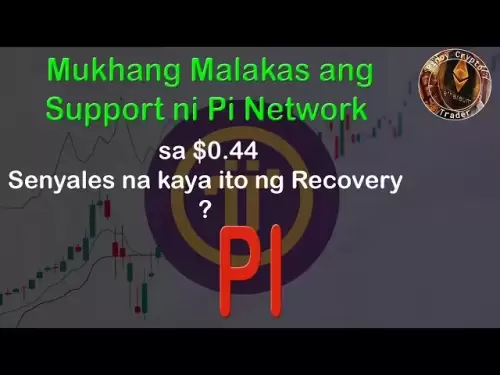-
 Bitcoin
Bitcoin $108,708.8110
0.60% -
 Ethereum
Ethereum $2,561.6057
1.91% -
 Tether USDt
Tether USDt $1.0001
-0.03% -
 XRP
XRP $2.2795
0.57% -
 BNB
BNB $662.2393
1.00% -
 Solana
Solana $153.1346
3.74% -
 USDC
USDC $1.0000
0.00% -
 TRON
TRON $0.2877
0.97% -
 Dogecoin
Dogecoin $0.1710
3.93% -
 Cardano
Cardano $0.5871
1.61% -
 Hyperliquid
Hyperliquid $39.6663
1.68% -
 Sui
Sui $2.9032
0.79% -
 Bitcoin Cash
Bitcoin Cash $496.1879
1.71% -
 Chainlink
Chainlink $13.5807
3.01% -
 UNUS SED LEO
UNUS SED LEO $9.0777
0.61% -
 Stellar
Stellar $0.2514
4.51% -
 Avalanche
Avalanche $18.1761
1.86% -
 Shiba Inu
Shiba Inu $0.0...01173
1.72% -
 Toncoin
Toncoin $2.8010
-4.23% -
 Hedera
Hedera $0.1594
3.21% -
 Litecoin
Litecoin $87.0257
-0.53% -
 Monero
Monero $319.1217
1.79% -
 Polkadot
Polkadot $3.3853
0.68% -
 Dai
Dai $0.9999
-0.01% -
 Ethena USDe
Ethena USDe $1.0003
0.02% -
 Bitget Token
Bitget Token $4.3420
-0.97% -
 Uniswap
Uniswap $7.3772
1.39% -
 Aave
Aave $286.6277
5.61% -
 Pepe
Pepe $0.0...09994
2.33% -
 Pi
Pi $0.4589
1.76%
How to judge the buying and selling timing of SUI through changes in trading volume?
High trading volume with rising SUI prices signals strong buying interest, while high volume with falling prices may indicate panic selling.
Apr 24, 2025 at 04:08 pm
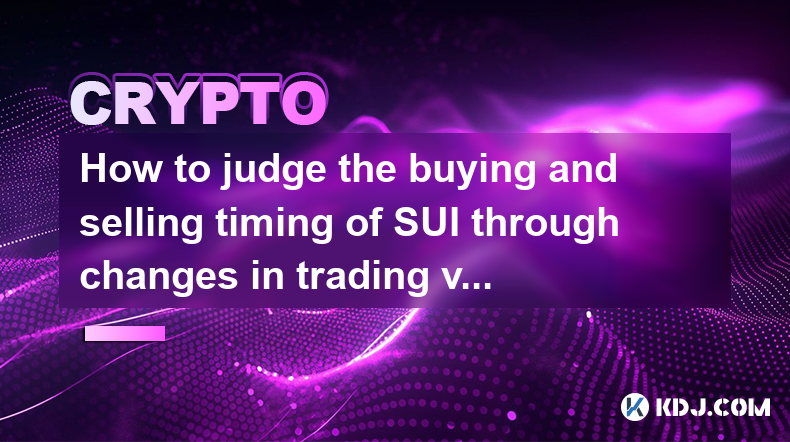
Understanding SUI and Trading Volume
SUI is a cryptocurrency that, like many others, is subject to the ebbs and flows of market dynamics. One of the critical indicators that traders use to gauge the right timing for buying and selling SUI is trading volume. Trading volume refers to the number of SUI units traded within a given period, typically measured on a daily basis. It serves as a powerful tool to understand market sentiment and potential price movements.
The Relationship Between Trading Volume and Price
The relationship between trading volume and price is fundamental to understanding market trends. When trading volume increases, it often indicates that more traders are interested in SUI, which can lead to significant price movements. Conversely, a decrease in trading volume might suggest a lack of interest or a consolidation period, where the price might not change much.
To effectively judge the buying and selling timing of SUI, it's crucial to analyze how trading volume correlates with price changes. High trading volume accompanied by a rising price often signals strong buying interest and bullish sentiment. On the other hand, high trading volume with a falling price might indicate panic selling or bearish sentiment.
Using Trading Volume to Identify Buying Opportunities
Identifying the right moment to buy SUI can be challenging, but trading volume can provide valuable insights. Here are some scenarios where trading volume might suggest a buying opportunity:
- Breakout with High Volume: If SUI breaks out of a resistance level with a significant increase in trading volume, it might be a good time to buy. This scenario suggests that many traders are confident in the upward movement of the price.
- Volume Precedes Price: Sometimes, a surge in trading volume can precede a price increase. If you notice a sharp rise in volume without a corresponding price change, it might indicate that a price increase is imminent.
- Volume at Support Levels: If SUI reaches a known support level and the trading volume increases, it might be a signal that the price is about to rebound. Buying at these levels can be advantageous as the price may soon start to rise.
Using Trading Volume to Identify Selling Opportunities
Just as trading volume can signal when to buy, it can also indicate when to sell SUI. Here are some scenarios where trading volume might suggest a selling opportunity:
- Breakdown with High Volume: If SUI breaks down through a support level with a significant increase in trading volume, it might be a good time to sell. This scenario suggests that many traders are losing confidence in the asset, and the price might continue to fall.
- Volume at Resistance Levels: If SUI reaches a known resistance level and the trading volume increases, it might be a signal that the price is about to drop. Selling at these levels can be advantageous as the price may soon start to decline.
- Divergence Between Volume and Price: If the price of SUI continues to rise but the trading volume starts to decrease, it might indicate that the upward trend is losing momentum. This divergence can be a signal to sell before the price potentially reverses.
Practical Steps to Analyze SUI Trading Volume
To effectively use trading volume to judge the buying and selling timing of SUI, follow these practical steps:
- Choose a Reliable Trading Platform: Select a platform that provides real-time data on SUI trading volume and price. Popular platforms include Binance, Coinbase, and Kraken.
- Use Volume Indicators: Utilize volume indicators such as the Volume Oscillator or On-Balance Volume (OBV) to get a clearer picture of volume trends.
- Monitor Volume and Price Charts: Regularly check the charts to see how trading volume correlates with price movements. Look for patterns such as volume spikes or divergences.
- Set Alerts: Set up alerts on your trading platform to notify you when there are significant changes in SUI trading volume or price.
- Backtest Your Strategy: Use historical data to backtest your strategy of using trading volume to buy and sell SUI. This can help you refine your approach and increase your confidence in making decisions.
Combining Volume with Other Indicators
While trading volume is a powerful tool, it's often more effective when combined with other technical indicators. Here are some additional indicators that can complement your analysis of SUI trading volume:
- Moving Averages: Use moving averages to identify trends and potential reversal points. A crossover of short-term and long-term moving averages can provide additional confirmation of a trend change.
- Relative Strength Index (RSI): The RSI can help identify overbought or oversold conditions. When combined with volume, it can provide a more comprehensive view of market sentiment.
- MACD (Moving Average Convergence Divergence): The MACD can help confirm trends and potential reversals. When the MACD line crosses above or below the signal line, it can provide additional signals for buying or selling SUI.
FAQs
Q: Can trading volume alone predict the future price of SUI?
A: While trading volume is a crucial indicator, it cannot predict the future price of SUI with certainty. It should be used in conjunction with other technical and fundamental analysis tools to make more informed trading decisions.
Q: How often should I check the trading volume of SUI?
A: The frequency of checking trading volume depends on your trading style. For day traders, checking volume every few minutes or hours might be necessary. For swing traders or long-term investors, daily or weekly checks might suffice.
Q: Is it possible to automate the analysis of SUI trading volume?
A: Yes, it is possible to automate the analysis of SUI trading volume using trading bots or algorithms. These tools can monitor volume and other indicators, execute trades based on predefined criteria, and help you make more timely decisions.
Q: How can I differentiate between normal volume fluctuations and significant volume changes in SUI?
A: To differentiate between normal and significant volume changes, compare the current volume to historical averages. A significant change is typically a volume spike that is much higher than the average volume over a recent period, such as the past 30 days.
Disclaimer:info@kdj.com
The information provided is not trading advice. kdj.com does not assume any responsibility for any investments made based on the information provided in this article. Cryptocurrencies are highly volatile and it is highly recommended that you invest with caution after thorough research!
If you believe that the content used on this website infringes your copyright, please contact us immediately (info@kdj.com) and we will delete it promptly.
- BBVA's Crypto Leap: Bitcoin and Ethereum for the Masses?
- 2025-07-07 22:30:12
- Bitcoin, Strategy, and Windfalls: Decoding the Latest Moves
- 2025-07-07 22:30:12
- Bitcoin Mempool at Historical Lows: Trouble on the Horizon?
- 2025-07-07 21:10:12
- CleanSpark Dominates Bitcoin Mining: 50 EH/s and Beyond
- 2025-07-07 21:50:12
- BitFuFu's Bitcoin Mining Momentum: Hashrate Expansion and Market Dynamics in 2025
- 2025-07-07 21:15:12
- Pi Network's Studio Upgrade: Building the Web3 App Store, One Pioneer at a Time
- 2025-07-07 21:50:12
Related knowledge
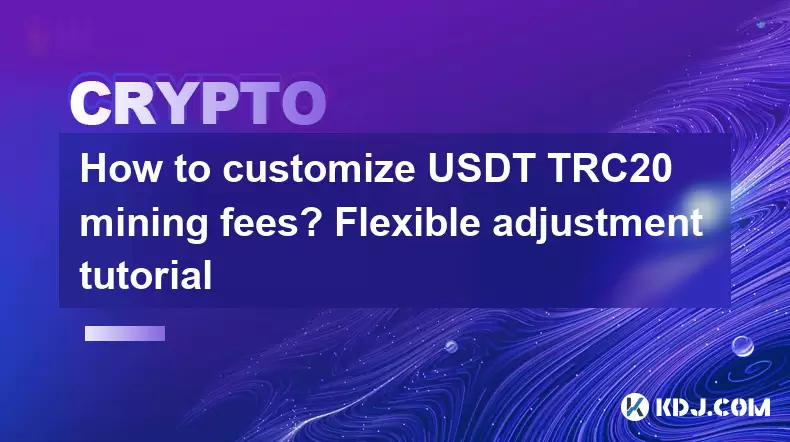
How to customize USDT TRC20 mining fees? Flexible adjustment tutorial
Jun 13,2025 at 01:42am
Understanding USDT TRC20 Mining FeesMining fees on the TRON (TRC20) network are essential for processing transactions. Unlike Bitcoin or Ethereum, where miners directly validate transactions, TRON uses a delegated proof-of-stake (DPoS) mechanism. However, users still need to pay bandwidth and energy fees, which are collectively referred to as 'mining fe...
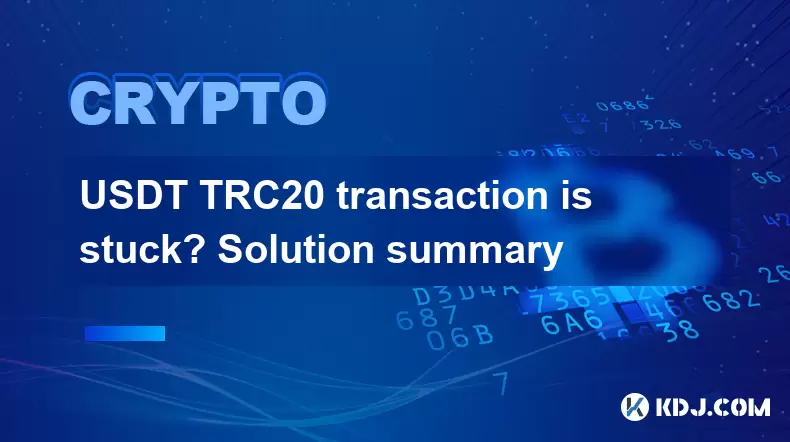
USDT TRC20 transaction is stuck? Solution summary
Jun 14,2025 at 11:15pm
Understanding USDT TRC20 TransactionsWhen users mention that a USDT TRC20 transaction is stuck, they typically refer to a situation where the transfer of Tether (USDT) on the TRON blockchain has not been confirmed for an extended period. This issue may arise due to various reasons such as network congestion, insufficient transaction fees, or wallet-rela...
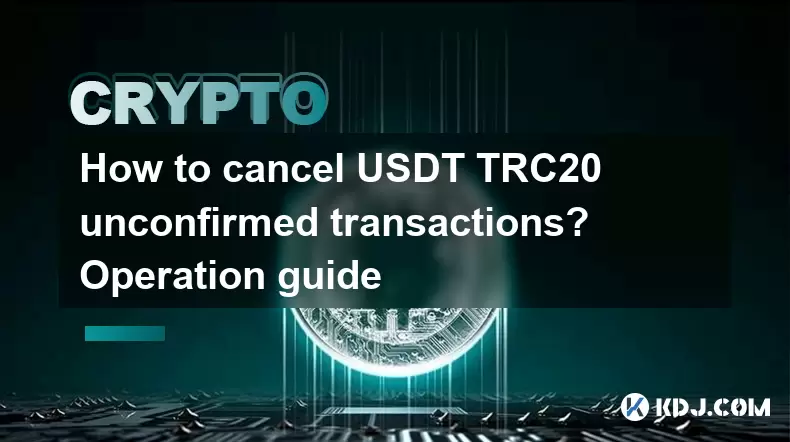
How to cancel USDT TRC20 unconfirmed transactions? Operation guide
Jun 13,2025 at 11:01pm
Understanding USDT TRC20 Unconfirmed TransactionsWhen dealing with USDT TRC20 transactions, it’s crucial to understand what an unconfirmed transaction means. An unconfirmed transaction is one that has been broadcasted to the blockchain network but hasn’t yet been included in a block. This typically occurs due to low transaction fees or network congestio...
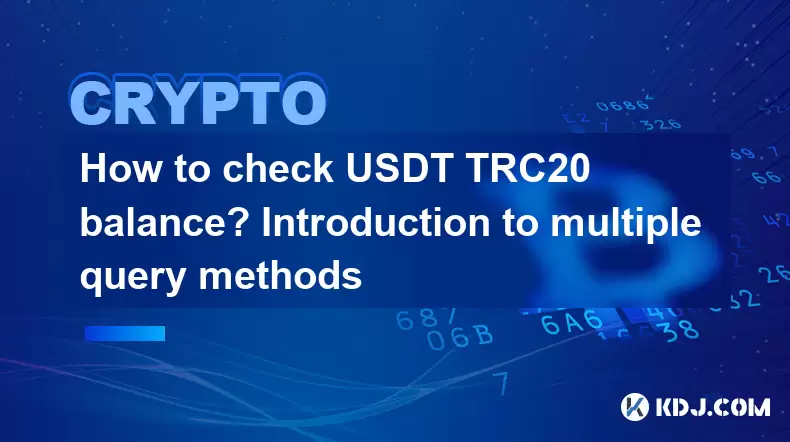
How to check USDT TRC20 balance? Introduction to multiple query methods
Jun 21,2025 at 02:42am
Understanding USDT TRC20 and Its ImportanceUSDT (Tether) is one of the most widely used stablecoins in the cryptocurrency market. It exists on multiple blockchain networks, including TRC20, which operates on the Tron (TRX) network. Checking your USDT TRC20 balance accurately is crucial for users who hold or transact with this asset. Whether you're sendi...
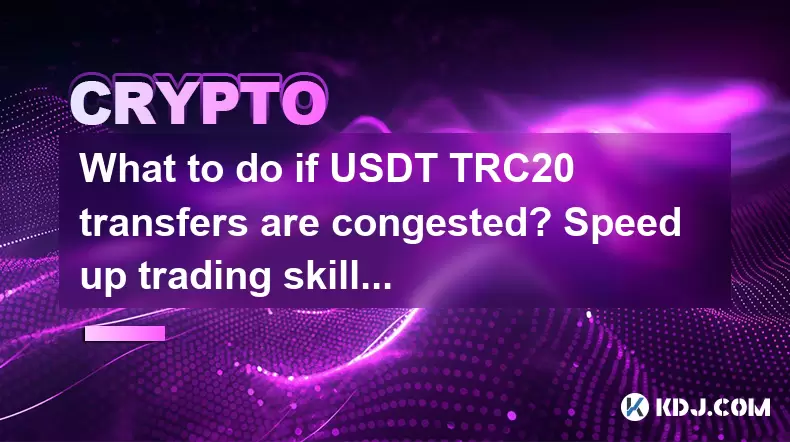
What to do if USDT TRC20 transfers are congested? Speed up trading skills
Jun 13,2025 at 09:56am
Understanding USDT TRC20 Transfer CongestionWhen transferring USDT TRC20, users may occasionally experience delays or congestion. This typically occurs due to network overload on the TRON blockchain, which hosts the TRC20 version of Tether. Unlike the ERC20 variant (which runs on Ethereum), TRC20 transactions are generally faster and cheaper, but during...
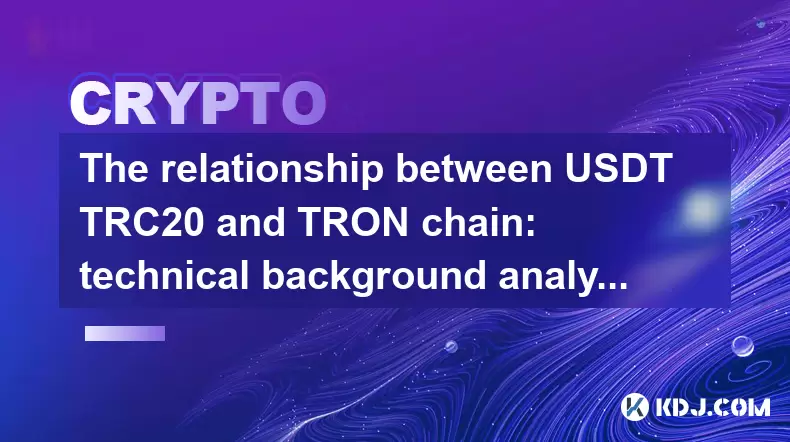
The relationship between USDT TRC20 and TRON chain: technical background analysis
Jun 12,2025 at 01:28pm
What is USDT TRC20?USDT TRC20 refers to the Tether (USDT) token issued on the TRON blockchain using the TRC-20 standard. Unlike the more commonly known ERC-20 version of USDT (which runs on Ethereum), the TRC-20 variant leverages the TRON network's infrastructure for faster and cheaper transactions. The emergence of this version came as part of Tether’s...

How to customize USDT TRC20 mining fees? Flexible adjustment tutorial
Jun 13,2025 at 01:42am
Understanding USDT TRC20 Mining FeesMining fees on the TRON (TRC20) network are essential for processing transactions. Unlike Bitcoin or Ethereum, where miners directly validate transactions, TRON uses a delegated proof-of-stake (DPoS) mechanism. However, users still need to pay bandwidth and energy fees, which are collectively referred to as 'mining fe...

USDT TRC20 transaction is stuck? Solution summary
Jun 14,2025 at 11:15pm
Understanding USDT TRC20 TransactionsWhen users mention that a USDT TRC20 transaction is stuck, they typically refer to a situation where the transfer of Tether (USDT) on the TRON blockchain has not been confirmed for an extended period. This issue may arise due to various reasons such as network congestion, insufficient transaction fees, or wallet-rela...

How to cancel USDT TRC20 unconfirmed transactions? Operation guide
Jun 13,2025 at 11:01pm
Understanding USDT TRC20 Unconfirmed TransactionsWhen dealing with USDT TRC20 transactions, it’s crucial to understand what an unconfirmed transaction means. An unconfirmed transaction is one that has been broadcasted to the blockchain network but hasn’t yet been included in a block. This typically occurs due to low transaction fees or network congestio...

How to check USDT TRC20 balance? Introduction to multiple query methods
Jun 21,2025 at 02:42am
Understanding USDT TRC20 and Its ImportanceUSDT (Tether) is one of the most widely used stablecoins in the cryptocurrency market. It exists on multiple blockchain networks, including TRC20, which operates on the Tron (TRX) network. Checking your USDT TRC20 balance accurately is crucial for users who hold or transact with this asset. Whether you're sendi...

What to do if USDT TRC20 transfers are congested? Speed up trading skills
Jun 13,2025 at 09:56am
Understanding USDT TRC20 Transfer CongestionWhen transferring USDT TRC20, users may occasionally experience delays or congestion. This typically occurs due to network overload on the TRON blockchain, which hosts the TRC20 version of Tether. Unlike the ERC20 variant (which runs on Ethereum), TRC20 transactions are generally faster and cheaper, but during...

The relationship between USDT TRC20 and TRON chain: technical background analysis
Jun 12,2025 at 01:28pm
What is USDT TRC20?USDT TRC20 refers to the Tether (USDT) token issued on the TRON blockchain using the TRC-20 standard. Unlike the more commonly known ERC-20 version of USDT (which runs on Ethereum), the TRC-20 variant leverages the TRON network's infrastructure for faster and cheaper transactions. The emergence of this version came as part of Tether’s...
See all articles























